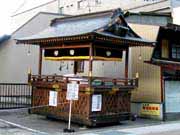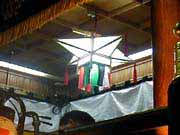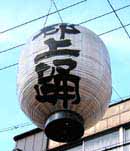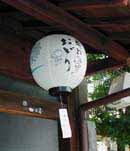Schedule, Program
Schedule – A Bon Dancing that is held for a “longest period” in Japan.
The big characteristic of Gujo Dancing is the length of its period. They start dancing (Odori hajime) from the middle of July and finish (Odori osame) dancing in the beginning of September. The period extends to more than a month, and this length is the longest period of Bon Dancing in every sense of the word.
Odori hajime (Start dancing)
Ennichi Odori
During this period, dancing is held somewhere in town almost everyday. Names like “Akiba Matsuri”, “Denki Jizou Matsuri” is named to the dance according to the location the dancing is held, and it is called “Ennichi Odori”.
Events like “Fancy dress contest” are included between the schedules.
Tetsuya Odori (All night dancing)
The highlight is “Tetsuya Odori” after all. They dance splendidly throughout the night in the days between August 13 and August 16.
The dance comes to its peak in the middle of Bon when the temperature reaches its height. The number of visitors also becomes the largest, and all around the town of Gujo Hachiman is filled with feverish excitement during this period. The local people unanimously say, “You must come to Tetsuya Odori if you want to see the true picture of Gujo Odori.”
The ones who really love the dance start joining from midnight.
In 1999, they danced in the rain.
Presently in the city, most Bon Dancing are danced from early evening to around 9 PM. Therefore, we think, “What a place of dance lovers it is that they dance throughout the night.” However, as a matter of fact, in the old times, it was normal anywhere in Japan to dance Bon Dancing throughout the night. This is due to the tradition of Japanese festivals from the earliest times, namely, “The main time of the festival is midnight.” Actually, the tradition of Tetsuya Odori still remains in several places like Niino of Nagano prefecture. Thanks to the local people who loved and cherished the tradition, we still can experience the true picture of Bon Dancing in the live form. Such thing is one of the many attractions of Gujo Dancing.
Odori Osame (Finish dancing)
Event
Program
The program of the day is;
Dance mainly “Kawasaki”, put other dances in between, and dance “Matsusaka” in the end.
Even if it rains, they keep dancing without worrying about it. People say that “They keep dancing until the warning of heavy rain and flood is issued.”
The big characteristic of Gujo Dancing is the length of its period. They start dancing (Odori hajime) from the middle of July and finish (Odori osame) dancing in the beginning of September. The period extends to more than a month, and this length is the longest period of Bon Dancing in every sense of the word.
Odori hajime (Start dancing)
Ennichi Odori
During this period, dancing is held somewhere in town almost everyday. Names like “Akiba Matsuri”, “Denki Jizou Matsuri” is named to the dance according to the location the dancing is held, and it is called “Ennichi Odori”.
Events like “Fancy dress contest” are included between the schedules.
Tetsuya Odori (All night dancing)
The highlight is “Tetsuya Odori” after all. They dance splendidly throughout the night in the days between August 13 and August 16.
The dance comes to its peak in the middle of Bon when the temperature reaches its height. The number of visitors also becomes the largest, and all around the town of Gujo Hachiman is filled with feverish excitement during this period. The local people unanimously say, “You must come to Tetsuya Odori if you want to see the true picture of Gujo Odori.”
The ones who really love the dance start joining from midnight.
In 1999, they danced in the rain.
Presently in the city, most Bon Dancing are danced from early evening to around 9 PM. Therefore, we think, “What a place of dance lovers it is that they dance throughout the night.” However, as a matter of fact, in the old times, it was normal anywhere in Japan to dance Bon Dancing throughout the night. This is due to the tradition of Japanese festivals from the earliest times, namely, “The main time of the festival is midnight.” Actually, the tradition of Tetsuya Odori still remains in several places like Niino of Nagano prefecture. Thanks to the local people who loved and cherished the tradition, we still can experience the true picture of Bon Dancing in the live form. Such thing is one of the many attractions of Gujo Dancing.
Odori Osame (Finish dancing)
Event
Program
The program of the day is;
Dance mainly “Kawasaki”, put other dances in between, and dance “Matsusaka” in the end.
Even if it rains, they keep dancing without worrying about it. People say that “They keep dancing until the warning of heavy rain and flood is issued.”
The location of dance
Gujo Dance is danced in various places within the town of Gujo Hachiman.
Square in front of the former town office
In case of special events like Odori Hajime and Odori Osame they dance in the square “in front of the former town office”. The former town office is located literally in the center of Gujo Hachiman; the end of ” Street” which is the main street of the town facing Yoshida River. It is a lovely building made of wood, and it is one of the important landscapes of the town of Gujo Hachiman.(Kiriko Lantern)” is hung in the skies of the square during the period of Gujo Dancing.
Shinmachi
Hashimoto-chou (Town of Hashimoto)
It is the downtown of ancient Gujo Hachiman, and it is the most crowded place. They dance in the streets that the atmosphere of Edo Era remains.
Facilities
Odori Yagura (Dancing Scaffold) – serves to liven up the dance
“Odori Yagura” is installed in the center of dancing venue every night. “Ondo tori (chorus leader)” and “Hayashi kata (accompanist)” take up their position in the scaffold, and undertake the task of singing and musical accompaniment. They serve to liven up the dance, an important factor that composes the “Dancing Scene” of Gujo Dancing.
It is left in the roadside in the daytime, but pulled out when the dance begins, and when the lanterns are lit up, it brings festive mood to the dancing venue.
Tatami mats are spread inside the scaffold, and it is equipped with tools and facilities for the accompanists, such as microphones, instruments, and cushions. It is circled with lanterns, and a sign is hung out to show the name of the dance that is currently danced (since there are 10 types of dances in Gujo Dance
The “Odori Yagura” of Gujo Hachiman was first built in the Taisho Era. The present one is ›th generation.
Before the Taisho Era, there was no “Odori Yagura” and dancing circles spread everywhere in town each in their own way.
Introduction of “Accompaniment music” such as samisen into Bon Dancing
It is a facility that is deeply concerned with the unity of the dancing circle
Kiriko Dourou (Kiriko Lantern)
A big lantern of a strange shape and a vivid decoration is hung in the sky of the square of “the former town office” which will be the center of Gujo Dancing. This is the “Kiriko Dourou”, and it will be decorated in this place during the period of the dance.
And also, if you watch carefully, you will see a cute small-sized Kiriko Dourou decorated in the ceiling of Odori Yagura.
The Kiriko Dourou is originally an anchorage of the spirits, and still now, there are many regions where they decorate Kiriko Dourou in their Buddhist altar for the repose of the soul of the newly dead (new spirit).
Also, the characteristic shape that has horns in four sides originates in “Ko (basket)” which is the folkways of talisman to protect us from evil. It is considered that “Kiriko” means “Kiriko (kiri basket)”
The fact that Kiriko Dourou is decorated in the venue all along the dancing period is very symbolic. This shows that Gujo Dancing follows the original purpose of Bon Dancing, which is, meeting the spirits of the ancestors and the new spirits, and dancing together with them.
However, in the present times, there are many people who don’t know what Kiriko Dourou is, and also there may be few people who feel that they are dancing with the spirits. However, the Kiriko Dourou is a dear item that talks about the “memories” of the ancestors without words, by the fact that it is always decorated every year.
Kiriko Lantern in the Dancing Scaffold
Various paper lanterns
Big paper lanterns are hung in the main street and swinging by the wind. They are attracting the eyes of the visitors. I guess that this was introduced after the WW2. Small lanterns are decorated in front of stores.
The various lanterns make us recall that Bon Dancing is the “folkways of fire”, no matter if you are aware of it or not.
It also has the role to liven up the atmosphere of the town in a casual way.
A big lantern over the street
A lantern in the eaves




